How To Change Sound Settings In Windows 10
If you're having audio problems, the post-obit suggestions might help. The tips are listed in society, so start with the first one, see if that helps, and and then proceed to the next one if information technology doesn't.
If multiple audio output devices are available, cheque that you take the appropriate one selected. Here's how:
-
Select the Speakers icon on the taskbar.
-
Next, select the pointer to open a list of audio devices continued to your estimator.
-
Bank check that your audio is playing to the audio device you lot adopt, such equally a speaker or headphones.
If this doesn't assistance, continue to the next tip.
The audio troubleshooter might be able to gear up audio bug automatically.
To run the troubleshooter
-
In the search box on the taskbar, blazon sound troubleshooter, select Prepare and find issues with playing sound from the results, so select Next.
-
Select the device you want to troubleshoot and and then continue through the troubleshooter.
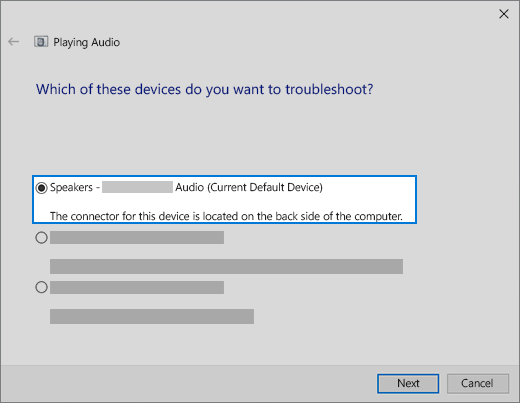
You lot can also launch the troubleshooter from audio Settings. Select Start > Settings > Organization > Sound > Troubleshoot.
If running the troubleshooter doesn't assist, continue to the next tip.
To bank check for updates
-
Select Start > Settings > Update & Security > Windows Update > Bank check for updates.
-
Do one of the post-obit:
-
If the status says "You're up to engagement, go to the next tip.
-
If the status says "Updates are available," select Install now.
-
-
Select the updates y'all want to install, and so select Install.
-
Restart your PC and see if your sound is working properly.
If that didn't solve your trouble, go along to the adjacent tip.
Try these steps
-
Bank check your speaker and headphone connections for loose cords or cables. Make certain all cords and cables are plugged in.
-
If you lot take multiple 5mm jacks to plug into, especially on a environment audio system, make sure all cords and cables are plugged into the correct jack.
-
If information technology'due south not clear which jack goes with which cord, consult your hardware manufacturer, or attempt the most obvious outputs 1 at a fourth dimension and encounter if they work.
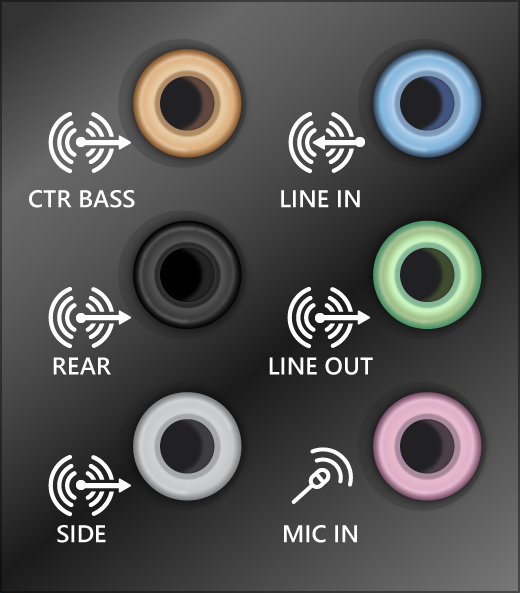
-
Note: Some systems utilise a green jack for output and pink for mic input and others volition exist labeled "headphone" or "microphone."
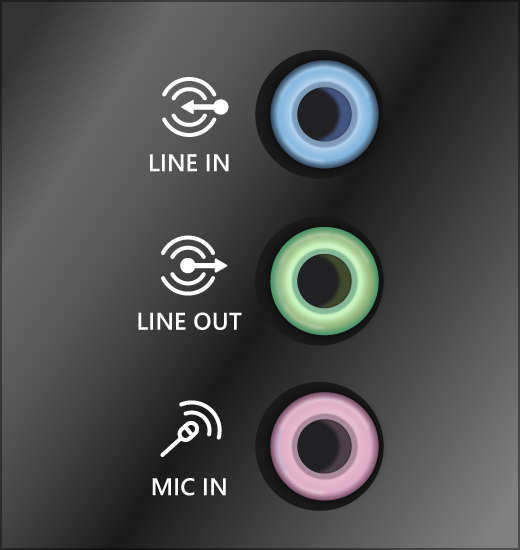
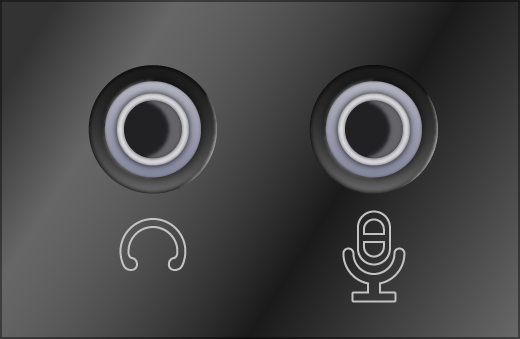
-
Make sure the ability is turned on and cheque the volume level.
-
Make sure the mute setting is not turned on, and try turning upwards all the volume controls.
-
Think some speakers and apps have their ain book controls. Be sure to check them all.
-
-
Endeavor connecting your speaker and headphones to a dissimilar USB port.
-
It's possible that your speakers won't work when your headphones are plugged in. Unplug your headphones and encounter if that helps.
If your cables and volume are OK, see the next sections for additional troubleshooting.
Cheque to make certain your audio devices aren't muted and haven't been disabled.
-
Right-click the Speakers icon on the taskbar, and so select Open Book mixer.
-
You'll see a set of volume controls for your devices. Make sure none of them are muted. If any of them are muted, you'll see a red circle with a line through information technology next to the book control. In that case, select the volume control to unmute.
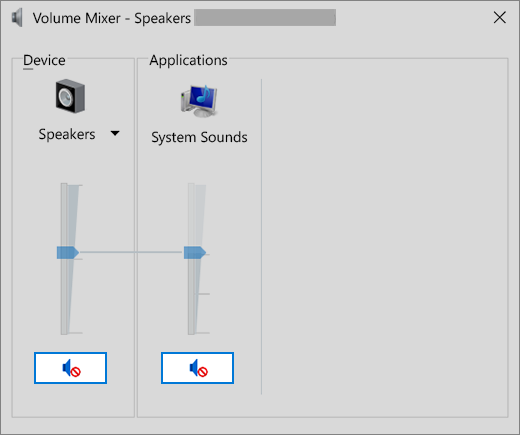
-
Bank check your device properties to brand certain that your devices accept not been disabled by error. Select Kickoff > Settings > Organization > Sound.
-
Select your audio device, and then select Device backdrop. Be sure to select Device properties for both the output and input devices.
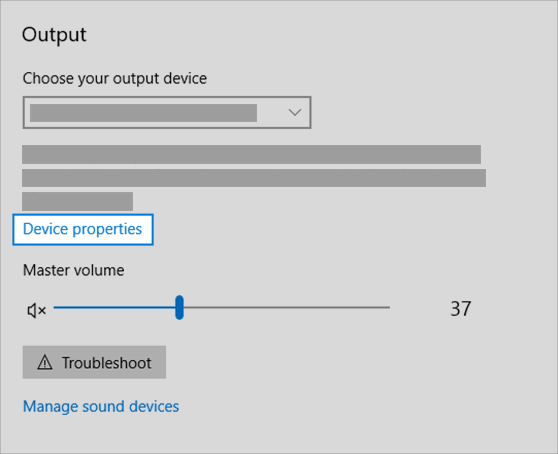
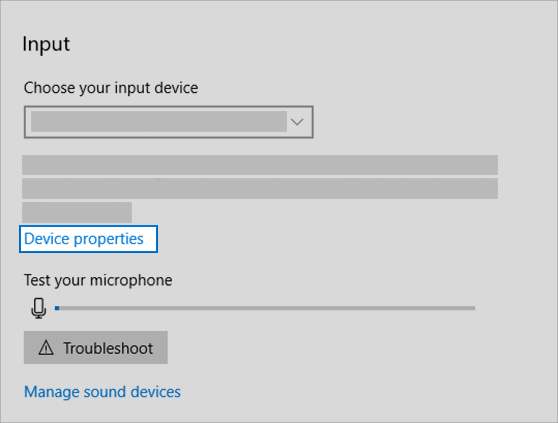
-
Brand certain the Disable check box is cleared for the output and input devices.
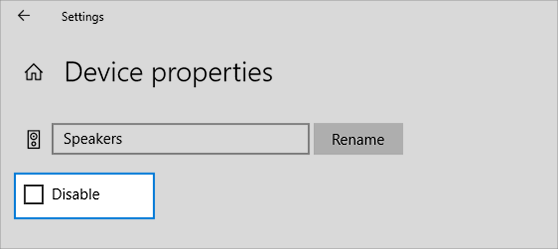
If that didn't solve your problem, continue to the next tip.
Hardware problems can be caused by outdated or malfunctioning drivers. Make sure your audio driver is up to date and update it if needed. If that doesn't work, try uninstalling the audio driver (information technology will reinstall automatically). If that doesn't piece of work, try using the generic audio driver that comes with Windows. If you lot're having sound issues after installing updates, effort rolling back your audio driver.
To update your audio driver automatically
-
In the search box on the taskbar, type device manager, then select information technology from the results.
-
Select the pointer next to Sound, video and game controllers to expand information technology.
-
Right-click the listing for your sound carte du jour or audio device, such as headphones or speakers, select Update driver, then select Search automatically for updated commuter software. Follow the instructions to complete the update.
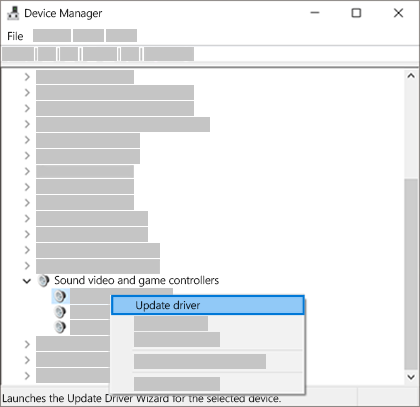
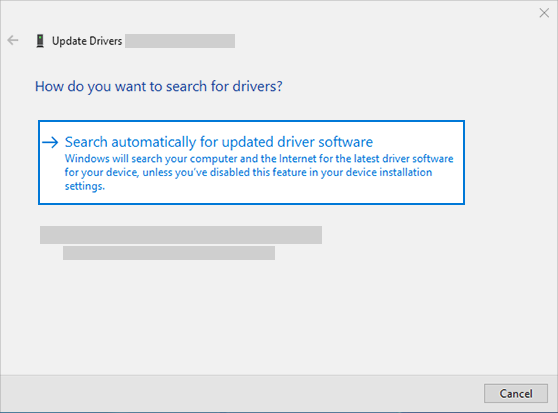
If Windows doesn't find a new driver, expect for ane on the device manufacturer's website and follow those instructions. If that doesn't work, attempt uninstalling your audio driver.
To uninstall your audio driver
-
In the search box on the taskbar, type device managing director, then select it from the results.
-
Select the arrow next to Sound, video and game controllers to expand it.
-
Right-click the listing for your sound card or audio device, select Uninstall device, select the Delete the driver software for this device check box, and so select Uninstall.
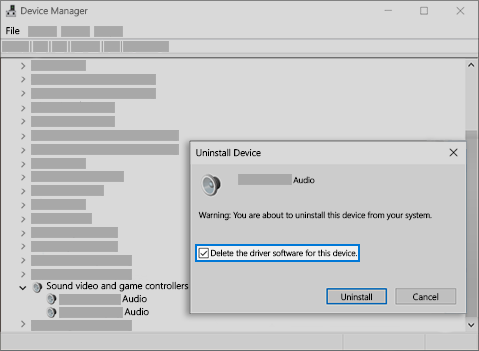
-
Restart your PC.
-
Notation: Be sure to relieve documents and any other current piece of work before you restart.
-
This restart volition automatically prompt your PC to reinstall your audio driver.
-
To restart, select Start > Power > Restart .
-
If those options didn't work, try using the generic audio driver that comes with Windows.
To use the generic audio driver that comes with Windows
-
In the search box on the taskbar, type device manager, then select it from the results.
-
Select the arrow next to Audio, video and game controllers to aggrandize it.
-
Right-click the listing for your sound card or audio device, and then select Update driver > Browse my computer for driver software > Allow me selection from a listing of device drivers on my computer.
-
Select the sound device whose driver you want to update, select Adjacent, and and then follow the instructions to install information technology.
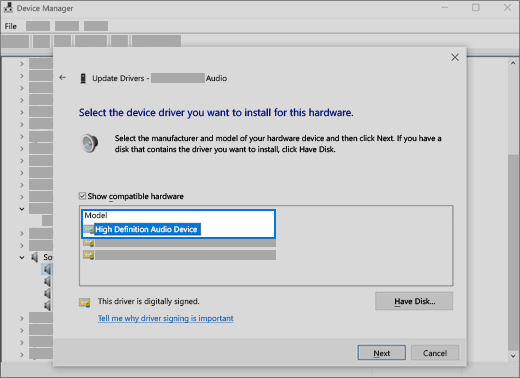
If these steps didn't solve your audio consequence, visit your device manufacturer's website and install the virtually recent sound/audio drivers for your device. Following is an case of a driver download page for a sound device manufacturer.
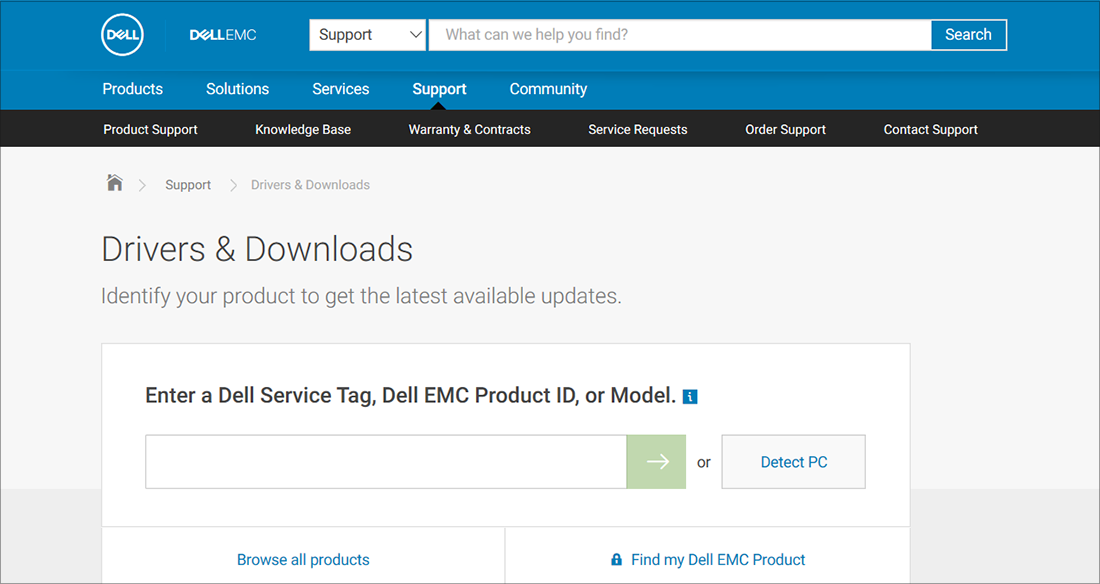
If you lot have audio bug after installing updates
If your sound was working before you ran Windows Update and now isn't working, endeavor rolling back your audio commuter.
To gyre back your audio driver
-
In the search box on the taskbar, type device managing director, then select it from the results.
-
Select the arrow next to Sound, video and game controllers to expand information technology.
-
Right-click the listing for your sound card or sound device, so select Properties.
-
Select the Driver tab, then select Roll Back Driver.
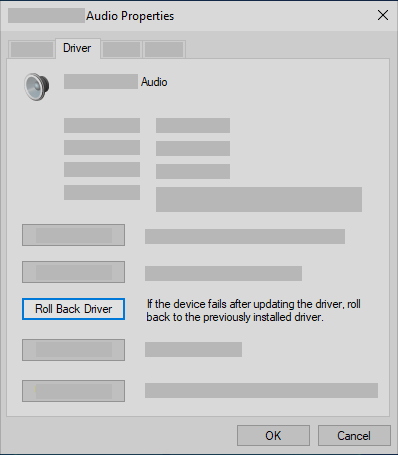
-
Read and follow the instructions and then select Yes if you want to whorl back your audio commuter.
If rolling back your audio driver didn't work or wasn't an pick, you can try to restore your PC from a organization restore point.
Restore your PC from a arrangement restore betoken
When Microsoft installs updates on your organisation, we create a system restore point in instance bug arise. Try restoring from that betoken and see if that fixes your sound problems. For more info, see "Restore from a organisation restore point" in Recovery options in Windows x.
If you're connecting to an audio device—such equally headphones or speakers—using USB or HDMI, y'all might need to set that device equally the default sound device. If y'all're using an external monitor that doesn't accept built-in speakers, make sure that the monitor isn't already selected as your default output device. if it is, you lot won't accept any audio. Yous can check that when you set your default output sound device. Here's how:
-
In the search box on the taskbar, type control panel, then select it from the results.
-
Select Hardware and Sound from the Control Panel, and so select Sound.
-
On the Playback tab, correct-click the listing for your audio device, select Fix as Default Device, and so select OK.
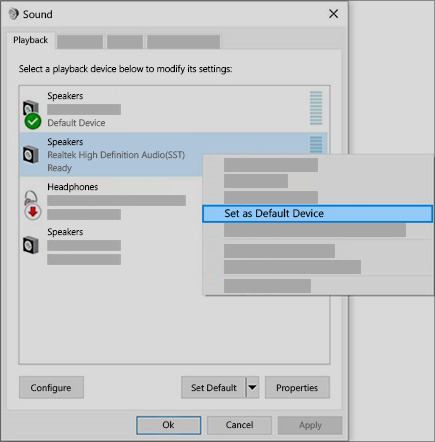
If setting your sound device as the default device doesn't assistance, continue to the next tip for additional troubleshooting.
Sometimes having audio enhancements on tin effect in audio bug. Disabling them may resolve your issue.
-
In the search box on the taskbar, blazon control panel, so select it from the results.
-
Select Hardware and Sound from the Command Panel, and then select Audio.
-
On the Playback tab, correct-click the Default Device, and so select Properties.
-
On the Enhancements tab, select either the Disable all enhancements or the Disable all sound furnishings check box (depending on which selection you meet), select OK, and endeavour to play your audio device.
-
If that doesn't work, on the Playback tab, select another default device (if you lot have i), select either the Disable all enhancements or the Disable all sound effects check box (depending on which option you meet), select OK, and try to play sound again. Do this for each default device.
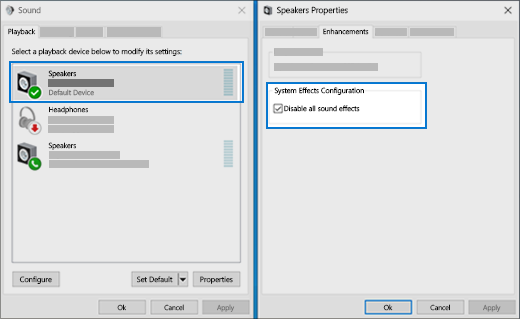
If turning off audio enhancements doesn't help, run across the next sections for boosted troubleshooting.
-
In the search box on the taskbar, blazon services, so select it from the results.
-
Select each of the post-obit services, right-click, and and then select Restart:
-
Windows Audio
-
Windows Sound Endpoint Builder
-
Remote Process Call (RPC)
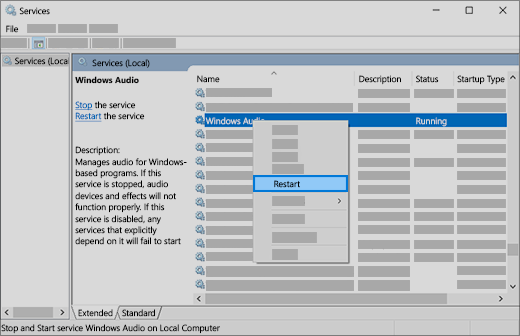
-
If restarting these services doesn't resolve your issue, see the next sections for more troubleshooting.
-
In the search box on the taskbar, type control console, and then select information technology from the results.
-
Select Hardware and Audio from the Command Panel, and then select Sound.
-
On the Playback tab, right-click (or press and concord) Default Device, and then select Properties.
-
On the Advanced tab, nether Default Format, change the setting, select OK,and then exam your audio device. If that doesn't piece of work, effort changing the setting again.
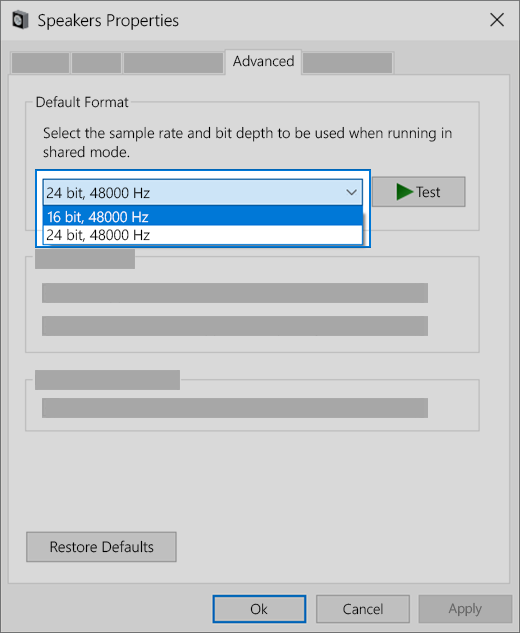
If trying different audio formats doesn't aid, see the next sections for additional troubleshooting.
Many updates require you to restart your device.
To check and see if yous have installed updates pending and need to restart
-
Save your work and shut all open applications.
-
Select Commencement > Power . If you have installed updates pending, you'll run into options to Update and restart and Update and shut down.
-
Select one of those restart options to apply the updates
Demand help with Windows Update? See Learn how to Troubleshoot problems updating Windows ten.
If restarting doesn't help, see the adjacent department for boosted troubleshooting.
Some audio problems might be caused by an issue with the sound system's IDT High Definition Audio CODEC. This can be fixed with a manual driver update which allows you to choose the sound driver you lot desire to use.
Note:Not all systems will have an IDT Loftier Definition Audio CODEC.
To check and see if you have one, and to manually update the driver
-
In the search box on the taskbar, type device director, then select it from the results.
-
Select the arrow side by side to Sound, video and game controllers to expand information technology.
-
Look for IDT High Definition Audio CODEC. If it'south listed, right-click it and select Update driver, then select Browse my computer for driver software > Let me choice from a list of device drivers on my computer.
-
You'll see a list of pre-installed drivers. Select High Definition Audio Device, and then select Next.
-
i. Select Start > Settings > Privacy , and then select Microphone from the left menu.
-
Under Let admission to the microphone on this device, select Change. Make certain the toggle is turned On.
-
If you're having this effect with a specific app, scroll down to Choose which Microsoft Shop apps can access your microphone and make certain that the toggle next to that app is turned On equally well.
How To Change Sound Settings In Windows 10,
Source: https://support.microsoft.com/en-us/windows/fix-sound-problems-in-windows-10-73025246-b61c-40fb-671a-2535c7cd56c8
Posted by: chienwrourner.blogspot.com


0 Response to "How To Change Sound Settings In Windows 10"
Post a Comment